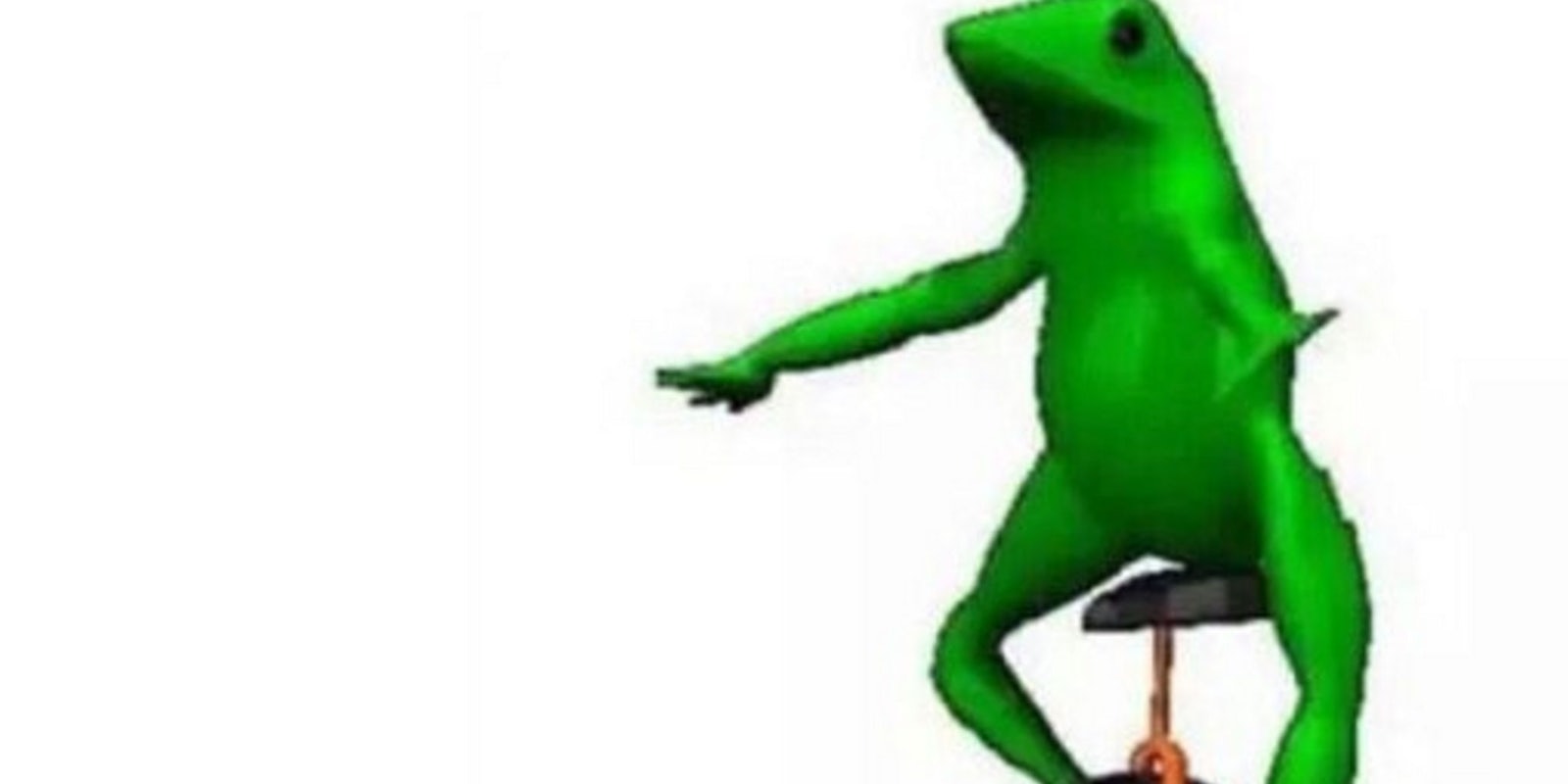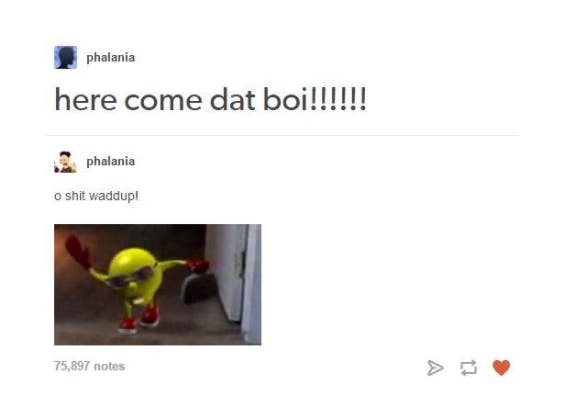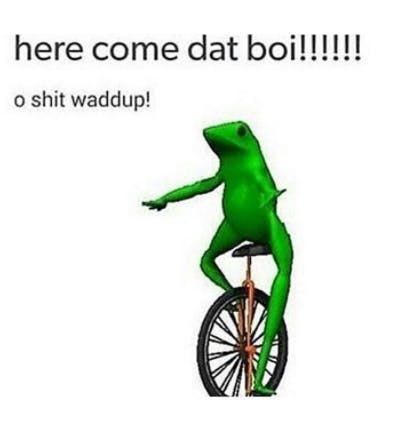In the innocent spring of 2016, Twitter users were confused—as usual. But this time, it wasn’t about politics, celebrities, or a fantasy TV show. It was about something else entirely.
The frog in question was Dat Boi, a primitively computer-animated frog on a unicycle who was suddenly riding unbidden into everyone’s timeline, and with no evident agenda.
Wherever Dat Boi came from, people seemed both surprised and thrilled to see him, greeting his arrival with a hearty “o shit waddup!” It seemed clear that he brought good tidings and effortless chill, an instant antidote to all that is toxic and bad online.
Dat Boi’s explosive virality was directly contingent on the joke of his mystery: He was not a reference or response to any familiar aspect of pop culture, and never appeared in any identifying context. Posting Dat Boi became funny insofar as there was nothing to “get” about him, which baffled some and greatly amused those who saw him as a direct descendant of Weird Facebook and Tumblr’s meme scene, where an idea’s complete separation from the conventional framework for humor is a hallmark of success. Dat Boi, you might say, was avant-garde.
In due course, Dat Boi’s hazy origins were revealed: The frog itself, as Select All reported, was created by an artist named Josh Doohen for “Animation Factory, a sort of Costco for weird animated GIFs” that arose in the dot-com frenzy of the late 1990s. Much in the way that stock photography companies create and hoard every conceivable image, no matter how bizarre, on the off-chance that someone will pay to license that specific picture, Animation Factory’s creatives were told to devise whatever weird thing popped into their heads.
READ MORE:
- 34 surprising exceptions to Rule 34
- The rise and fall of ‘Bye Felicia,’ this generation’s coldest reply
- The spammy history of ( ͡° ͜ʖ ͡°), Le Lenny Face
For more than a decade, Dat Boi was just one among many strange, unusable bits of intellectual property in this company’s portfolio. Meanwhile, with the advent of Web 2.0, the world of memes—often fueled by a heady mixture of nostalgia and irony—was born. By 2014, we saw the vernacular “Dat Boi” applied to a TV news photo of a wanted young man (along with a fake mustache). Then, in 2015, we got the formulation “here come dat boi!!!!!! / o shit waddup!” by way of Tumblr user phalania, who later deleted the post, according to Know Your Meme. Notably, the character here is an animated Pac-Man rather than a frog.
It wasn’t until April 3, 2016, that the internet was blessed with the Dat Boi we came to know and love. A Facebook page called Fresh Memes About the Mojave Desert and Other Delectable Cuisines is generally credited with the remix of phalania’s concept, which replaced Pac-Man with Animation Factory’s unicycling frog. That post, too, is now sadly lost to history.
Still, why is this particular frog “Dat Boi”? Why is he on a unicycle? Well, why not? The name just fits, and uncorrupted nature of this idle vision—hey, what the heck, let’s see cartoon a frog on a one-wheeled conveyance designed for bipeds—was enough to break down the walls of a usually cloistered meme society. For once, the inside joke had somehow gotten out.
This mainstreaming of an otherwise dank and obscure meme did not sit well with the radical fringe of the meme vanguard, however. Indeed, many of Dat Boi original discipline were nauseated by his acceptance into the society of non-exclusive “normie” memes, and even declared him “dead.” Not a few also accused your humble correspondent of “killing” Dat Boi by attempting to explain his appeal and spread his gospel. I was forced to reply in kind.
In a matter of hours, then, Dat Boi had gone from the hottest web commodity to something played-out and entirely used up. His value had been exhausted in part by oversaturation and, in another sense, by the sheer speed of his ascendance to iconic status. Dat Boi, and the brief civil war his popularity caused, simply couldn’t survive the burning glare of the spotlight.
Over the months that followed, Dat Boi’s legacy of genteel grace was subsumed by interest in another frog meme whose fortunes had turned: Pepe the Frog, a comic book character once known for being as free and easy-going as Dat Boi, then as a mascot of sorts for the message board 4chan, was resurrected as a symbol for the internet’s Trump-supporting neo-Nazis. Yet even he was not immune to Dat Boi’s charms.
Dat Boi, by comparison, has never been co-opted for hate speech. He joins the pantheon of timeless frog memes alongside “Kermit sipping tea,” as an emblem of enduring hope and calm. In fact, when all is said and done, he may be the last thing standing between us and total fascism.
When you get right down to it, Dat Boi is more than a hero. He’s many heroes. He is anyone who ever unicycled for what they believe in. He is the consummate everyman, unassuming and unpretentious. If, overnight, Earth’s population were magically transformed into billions of Dat Bois, it would mean the end of war, famine, and futility. It would be a paradise. And however improbable that sounds, we must never stop dreaming of the mere possibility.
Long live Dat Boi.
Editor’s note: This article has been revised to provide a more comprehensive overview of the rise and fall of Dat Boi.




 (@ShiaLeBoofPack)
(@ShiaLeBoofPack) 